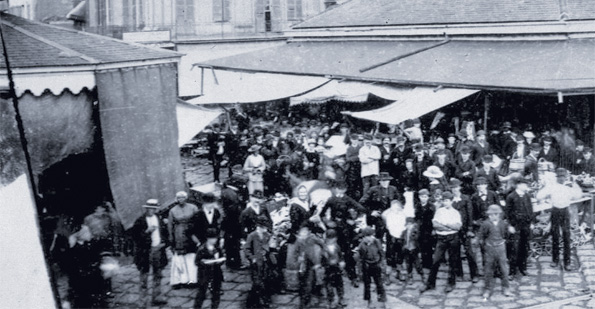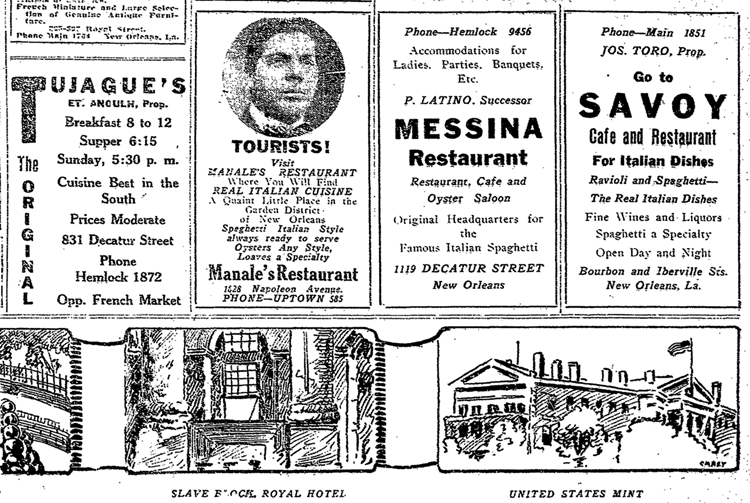Foodways
The Rise of the Spaghetti District
Pasta’s remarkable arrival in New Orleans
Published: March 1, 2016
Last Updated: January 3, 2019

Courtesy of the Louisiana State Museum.
The intersection of Decatur St. and the corner St. Philip, was considered the epicenter of the Sicilian Quarter at the turn of the century.
Four years earlier, organizers of a banquet for mortgage bankers and their wives at the old St. Louis Exchange hired Messina’s Restaurant from nearby Decatur Street to serve an authentic spaghetti dinner. Watching bewildered diners struggle with their spoons, forks, and red gravy, an observer noted, “such a supper is a matter of education, and not all those present were educated to eat it.”
Italian food is such a staple of the American diet today that it is difficult for us to imagine a time when, outside the immigrant community, folks considered pasta a curiosity—certainly true at the turn of the twentieth century in New Orleans. Yet in the space of barely a decade, “the real Italian spaghetti” went from a mystifying ethnic curiosity to a staple of the city’s dining scene. In the process, it fused with local ingredients and dishes to give birth to what we today call Creole Italian cuisine. By 1916, the French Quarter was not only one of the nation’s macaroni manufacturing hubs—it had also gained renown as the place one could dine on “authentic” Italian food while listening to a popular new form of music called jazz.
Inexpensive “macaroni” noodles were, of course, not new at all in 1900—they had been around since at least the seventeenth century, and had become a culinary curiosity beyond their native Naples by the late 18th century. Thomas Jefferson imported the first hydraulic pasta machine to America in 1789. By the early 1830s, a Spaniard named Francisco Sambola’s Decatur Street factory manufactured macaroni and other wheat products, like vermicelli noodles. But it was not until the city witnessed a noticeable uptick of Italian immigrants that demand for pasta really began to take off in the Crescent City. However, macaroni noodles remained an exotic novelty for most Americans in 1900, with ladies’ column recipes advocating its preparation through interminable boiling followed by baking it drowned in butter and cheese.
From both a cultural, geographical, and genealogical standpoint, when we speak of “Italian” in New Orleans we really mean “Sicilian;” the origin of over 90 percent of the city’s self-identifying Italians. Sicilians first came in significant numbers to New Orleans in the 1830s on the back of the Mediterranean citrus trade. Until they were overtaken by California in 1938, Sicily was the world’s leading producer of lemons, a fruit grown in the fertile valleys of the island’s Conca d’Oro. Sicilian citrus merchants established trading houses along Decatur Street by the 1850s, and in decades came to dominate the importation and wholesaling of produce in the Mississippi Valley. Yet this was only the beginning of their ascent: the advent of the tramp steamer around 1880 forever revolutionized their business, cutting the cost and time it took to sail between the Gulf and Mediterranean in half and allowing for diversification in the far more lucrative tropical fruit trade. This steam-powered citrus fleet also offered Sicily’s rural poor relatively cheap transportation to the Americas. Driven from the island by poverty and political instability and attracted by the prospect of property ownership after a purgatorial tenure harvesting cane, digging levees, and felling pine trees, they came ashore at the Nicholls Street Wharf and melted into the Lower Quarter by the thousands. The eventual arrival of 45,000 Sicilians to Louisiana by 1910 created an especially large and lucrative native market for Italian-style pasta.

This 1916 advertisement from the Daily States Newspaper demonstrates La Nasa Italian Restaurant mingling Creole and Italian favorites. Courtesy of the author
The career of Giacomo “Jacob” Cusimano paralleled the rise of the pasta industry in New Orleans. A citrus trader from Palermo, Cusimano arrived in 1882 and by the late 1890s had diversified into macaroni with a small factory at 625 St. Philip. (The site of Ruffino’s Restaurant and Bakery for much of the twentieth century.) His business flourished so much that by 1902 he built a large purpose-built factory at the corner of Barracks and Chartres capable of producing 10,000 pounds of pasta a day. Today this structure houses Le Richelieu Hotel, but it is hardly the only tangible remnant of Cusimano’s factory. His plant manager, Leon Tujague, formed a partnership with two other non-Italians in 1914 to form the Southern Macaroni Company, whose Luxury Brand pasta is still sold in grocery stores today (though owned by corporate giant ConAgra Foods). Cusimano’s generosity fostered multiple food industry titans. As the legend goes, in 1908, the merchant lent a financial lifeline to a penniless Guiseppe Uddo, the founder of what would later become Progresso Foods.
By the turn of the twentieth century, the Lower Quarter was not only home to macaroni factories, but also a growing number of what outsiders called “spaghetti houses.” These were unprepossessing diners that catered to the neighborhood’s ethnic population. Italians, particularly from the tiny island of Ustica, had operated restaurants and oyster saloons in the city since the 1840s, including Tranchina’s at West End and Commander’s Palace, but these houses were known for seafood and French-language menus, not Italian food. The red gravy spaghetti restaurant, the progenitor of what today we would call “Creole Italian” cuisine, first appeared sometime in the 1890s in the French Quarter.
Typical of this emergent style of cuisine in both form and fashion was the spaghetti house at 1019 Decatur Street, converted from a seamen’s bar by the LaNasa brothers around 1900. Located across from the French Market, it promised that its “spagetti [sic] and macaroni” were the best in the city, and the brothers did a strong business with the blue-collar clientele of the riverfront. Eventually dubbed “LaNasa Italian Restaurant,” the establishment’s menu steadily grew more elaborate. A large display advertisement from 1916 suggested aspirations to elegance by mirroring fashionable multi-course French language table d’hôte menus, only in Italian. The meal began with “anchovie and olives,” followed by a “Ostrica a la Chef” (oyster) soup, the classical French “Filet Sole a la Orly,” but rounded out with a decidedly Italian entrée, “Cottoletti di Dendo con Piselli (veal cutlet), Spaghetti a La Nasa,” and “Cauliflower a Caruso,” before closing with a veal dish named for the Duke of Genoa, biscotti and cheeses, coffee, and Chianti. LaNasa’s kitchen produced local foods like Pompano and oysters alongside chicken cacciatore. It also served brosciollone (more commonly spelled bruciolone), the classic New Orleans Sicilian dish consisting of a veal pocket filled and rolled with stuffing and hard-boiled egg. This fusion of gulf bounty and ethnic preparations marked LaNasa’s cuisine as what we would identify today as “Creole Italian,” a name that came into regular usage during the 1970s.
In the space of barely a decade, “the real Italian spaghetti” went from a mystifying ethnic curiosity to a staple of the city’s dining scene.
To use a modern term, Italian food had somehow become “hip” in late 1910s’ New Orleans, not unlike the way that people outside of the Vietnamese community “discovered” Vietnamese food in the Gulf South during the 2000s. The perplexed mortgage bankers in 1908 and the intrepid Will Branan in 1912 may have been in the vanguard of culinary cosmopolitanism, but only just. Indeed, the pace with which mainstream America embraced spaghetti is truly remarkable, a process accelerated by the start of World War I in Europe. An advertising section run in States during the horseracing season of 1916, trimmed in illustrations of “points of interest to visitors in quaint historic New Orleans,” featured ads for Antoine’s, Tujague’s, and the Old Absinthe House. Yet it also included three ads for relatively new spaghetti houses. A photograph of Frank Manale headed copy that beckoned tourists to his “quaint little place in the Garden District.” Just three years into its existence, what we know today as Pascal’s Manale was a Creole Italian restaurant serving “oysters any style” alongside “spaghetti Italian style.” To the right of Manale’s ad ran another for Messina’s Restaurant at 1119 Decatur Street, boasting its role as the “Original Headquarters for the Famous Italian Spaghetti.” A third ad for Joseph Toro’s Savoy Café and Restaurant, located at the corner of Bourbon and Iberville Streets promised “Real Italian Dishes,” but the menu’s nascent Creole Italian cuisine was as much local as it was Sicilian, including turtle soup, “slices of the tenderloin of a large fresh trout,” and “chicken sauté with mushrooms,” a probable chicken cacciatore dish.
The most enduring institution of its kind to open in the young twentieth century, however, was Turci’s, a restaurant that embodied the rise of Italian food in the city (and one remembered by most New Orleanians for its last location on Poydras Street, where it moved in 1945). Turci’s first opened its doors in 1917 in the 800 block of Decatur Street, right next door to Madame Bégué’s Exchange, which had long become famous for its brunch. It was a smart place to situate a restaurant that catered to tourists in search of culinary adventure. Ettore Turci and his wife, Teresa Barteli, were traveling opera singers who first came to the United States in 1909 and, though they were not Sicilian—Ettore Turci was Bolognese, while Teresa was Neapolitan—their cooking proved enormously popular with New Orleanians, whether of Italian heritage or not.
The advent of Prohibition in 1919 marked a turning point for the Turcis and other restaurateurs, Italian and otherwise. In the span of a decade, the spaghetti house had gone from adventurous eating for the few to a place so mainstream that it was suitable for the Elk’s Ladies’ Auxiliary luncheon. Most also began offering evening shows with musicians playing jazz, which during these same years had become popular with the same clientele. When Turci’s moved to Bourbon Street in 1924, it featured white tablecloths, tuxedoed waiters, music, and illegal booze. Thus out of the modest spaghetti house grew the nightclub of Bourbon Street, and with it the beginning of another chapter in the city’s dining history.
—-
Justin Nystrom, Ph.D., is a professor at Loyola University in New Orleans where he serves as co-director of the Center for the Study of New Orleans; Director, Documentary and Oral History Studio. He is the author of New Orleans After the Civil War: Race, Politics and a New Birth of Freedom.
